Thousands of flamingos gathered on the shorelines, squawking and croaking, while others flying or wading in the shallow waters of Kenya's alkaline lakes along the Great Rift Valley created a vibrant pink spectacle — a scene that every bird-watcher shouldn't miss.
It's not only a wonderful unwinding experience for holidaymakers but also breathtaking to watch the birds' vibrant pink plumage, long legs and graceful movements as well as their gregarious habits.
As you get too close to the flamingos at the viewpoints, they protectively fly away, but if you stay a bit, you will watch them come back after a few minutes, and you are able to capture a memorable photo or a short video of the mesmerizing birds.
This experience is a reality at Lakes Nakuru, Bogoria and Elementaita, which are located along the Great Rift Valley. The three lakes, collectively termed the Kenya Lake System, have been recognized as UNESCO World Heritage Sites. Being alkaline lakes, they host thousands of flamingos and other birds that attract both international and local tourists.
For international visitors, it's worthy planning for at least a two-day trip to either visit the three or at least two of the lakes for adventurous safari. In addition to the flamingos, visitors can also view numerous other bird species and wild animals.
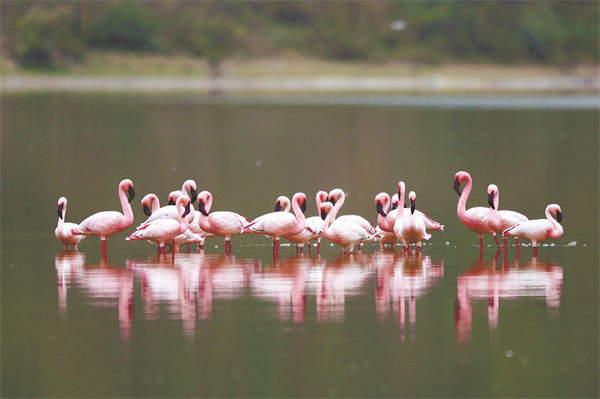
A flock of flamingos float on a tranquil lake.[Photo provided by Wang Yuxi/China Daily]
Lake Bogoria, the favorite spot
Lake Bogoria, located about 250 kilometers northwest of Nairobi, hosts a large population of the pink birds, probably because of abundant blue-green algae — the primary food source for flamingos — minimal competition and less predators.
The lake is home to both greater and lesser flamingos, the latter being particularly abundant. Greater flamingos are bigger and taller and have light pink beaks with a black tip. The lesser flamingos, on the other hand, have a deeper pink color on their feathers and their beaks are deep red with a black tip.
However, there are times that the number of flamingos fluctuates in all the three lakes, depending on the food availability and mating season.
James Kimaru, a senior warden at Lake Bogoria National Reserve, said that during the mating season, most flamingos migrate to Lake Natron, an alkaline lake in northern Tanzania near the Kenyan border, to breed.

Ostriches roam in the wetlands beside Lake Bogoria in Kenya.[Photo provided by Wang Yuxi/China Daily]
Lake Natron provides an ideal breeding place for flamingos because its harsh, alkaline environment acts as a natural barrier against predators. Its high salinity also supports the cyanobacteria that flamingos feed on.
As the lake's water evaporates, salt crystal islands emerge, providing nesting sites for flamingos. Chicks hatch between September and April.
Chris Relimoi, who has been working as a tour guide at Lake Bogoria National Reserve for 10 years, said that when flamingos come back, the chicks are usually white downy in color with black legs. Their distinctive pink color develops gradually as they grow and their diet changes. The shrimp, algae and plankton, which flamingos feed on, contain carotenoid that turns them into pink.
A flamingo lays one large egg in a year that hatches after 27 to 30 days. Both the male and female flamingos take turns in incubating the egg and also both feed the chick after hatching.
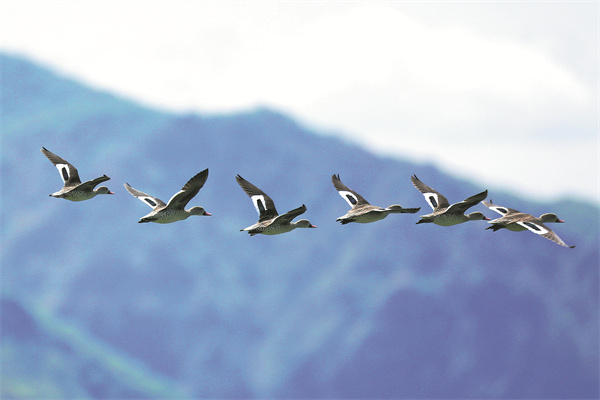
Wild animals gather on the shores of Lake Nakuru in Kenya.[Photo provided by Wang Yuxi/China Daily]
Notably, flamingos are adapted to drink water that approaches the boiling point. This is because some of them live in areas with high salt concentration, with the only source of fresh water being the boiling geysers. Flamingos can also tolerate extremely salty and alkaline water.
Kimaru said flamingos start returning to Lake Bogoria from mid-June, adding that, up to October the lake usually hosts thousands of flamingos, turning it into a pink lake. It is also the peak season for international tourists.
"Most of our tourists to Lake Bogoria are from China, representing 30 percent of our visitors. They are mainly interested in flamingos," he said, adding that the flamingos are also a key attraction to many other international tourists.
Besides the dazzling display of flamingos, the lake features bubbling geysers and hot water volcanic springs erupting along the banks and within the lake itself. They are the main attractions during the seasons when flamingos migrate for breeding.
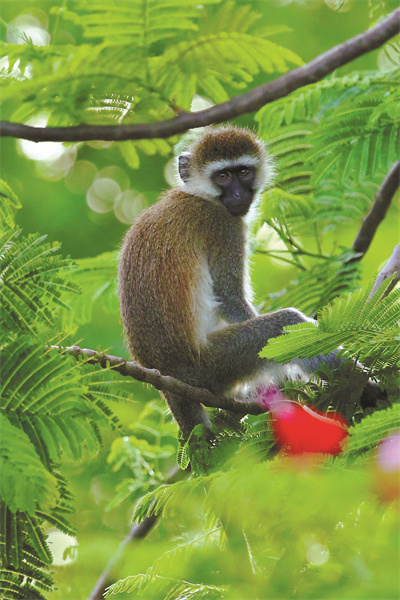
A vervet monkey perches on a tree.[Photo provided by Wang Yuxi/China Daily]
Many students also visit the lake's hot springs and geysers for handson learning in earth sciences, geology and natural phenomena, while also experiencing a unique and memorable field trip.
At the main entrance gate, local residents sell raw eggs that visitors can buy and boil in the hot springs.
Relimoi, the guide, said many hot springs and geysers have been submerged in the water and can only be seen if the water rescinds.
Apart from the flamingos, Lake Bogoria National Reserve also hosts ostriches, kudus, impalas, buffaloes, zebras, leopards and hyenas.
Francis Ang'awa, a professor of geography at Jaramogi Oginga Odinga University of Science and Technology in Kenya, who had brought students for field study at the lake, said the government should improve infrastructure to make the lake more accessible.
Currently, there is only one road leading from the entrance of the reserve to the shores of the lake, with most parts of the road bumpy.
"Better infrastructure will increase activities to the lake," he said, noting that there had been a better road, which was destroyed by floods during the last rainy season.
There are several accommodation facilities near Lake Bogoria, one being Lake Bogoria Spa Resort, which is famous for its natural heated spa pool, known as "the healing place" for its therapeutic values.
To reach Lake Bogoria National Reserve from Nairobi, visitors can join a guided tour or rent a car and drive themselves. It's a five-hour journey.
Several tour operators in Nairobi offer safari packages to Lake Bogoria, and most of the time they combine it with visits to other attractions such as Lake Nakuru, Lake Elementaita and Maasai Mara. There are no domestic flights to Lake Bogoria.
Foreign adults have to pay an entrance fee of $50, while it is $3.9 for Kenyan adults, and $1.7 for children and students.
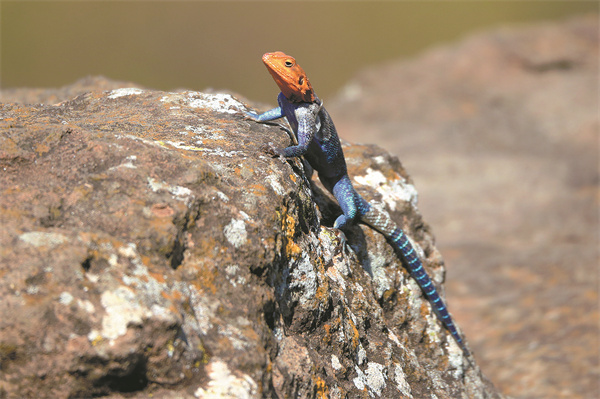
An Agama lionotus, commonly known as Kenyan rock agama, bask in the sun on a rock.[Photo provided by Wang Yuxi/China Daily]
Easily accessible Lake Nakuru
Located 156 kilometers west of Nairobi, Lake Nakuru is the easily accessible and one of the most famous tourist destinations among all the lakes in the country, featuring a large number of the pink flamingos attracted by the plenty of bluegreen algae on its shorelines.
For the huge population of flamingos, which hit 2 million a decade ago, United States ornithologist Roger Peterson termed the lake the "greatest bird spectacle on Earth".
However, the number of flamingos in the lake has decreased because of rising water levels that have reduced salinity. When the alkaline levels drop, the blue-green algae levels also decline, compelling the birds to migrate to other alkaline lakes, particularly Lake Bogoria, in search of food, though the lake has also been experiencing the flooding challenge.
The flock of flamingos in Lake Nakuru increases immediately after the rainy season because of abundant algae, and decreases during the dry season.
The birds can be viewed through several viewpoints, on the shores of the lake or from the comfort of your safari car.
Apart from the pink flamingos, Lake Nakuru is also home to hundreds of other waterfowls, with a large population of great white pelicans.
Besides its magnificent bird life, Lake Nakuru National Park is home to many wild animals.
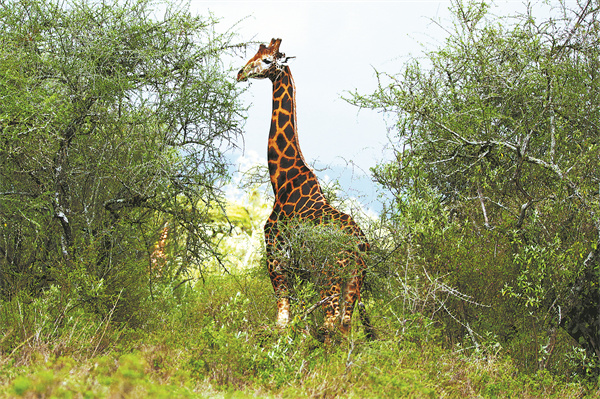
A giraffe stand tall among the bushes.[Photo provided by Wang Yuxi/China Daily]
It is easy to spot southern white rhinos, big herds of buffaloes grazing in the open grasslands, elands, shaggy waterbucks, Rothschild's giraffes and zebras. Predators such as leopards and lions also roam the park, while hippopotamuses can be found in the lake's northern region.
For a spectacular view of the wildlife, it's important for tourists to use a tour van with an open roof.
Several lodges within the park provide guests with the unique opportunity to witness breathtaking sunsets and experience the nocturnal activities of wildlife and flamingos. Additionally, the park's proximity to Nakuru city ensures a range of accommodation options, making for a comfortable and convenient trip.
To access Lake Nakuru National Park from Nairobi, visitors can drive via the Nairobi-Nakuru highway, a three-and-half-hour journey, or fly from Wilson Airport to Naishi airstrip within the park.
The park has three gates: Main Gate, Lanet Gate and Nderit Gate. Adult Kenyans and East African Community residents pay an entrance fee of $6.6, while children and students have to pay $1.7. For nonresidents or international tourists, it is $60 and $35 respectively for adults and children.
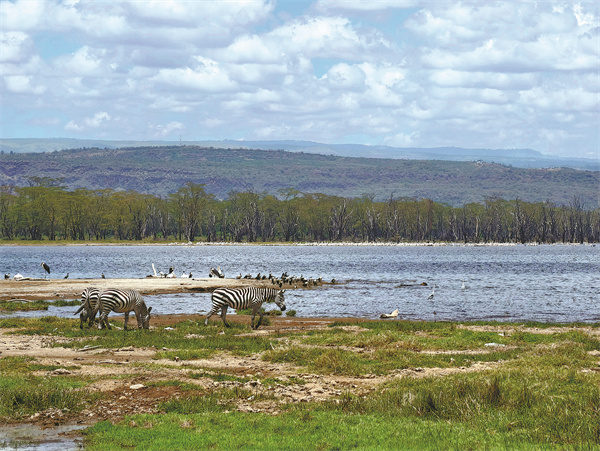
Wild animals gather on the shores of Lake Nakuru in Kenya.[Photo provided by Wang Yuxi/China Daily]
Lake Elementaita, haven for birdlife
Located 30 minutes' drive from Lake Nakuru, and about 120 kilometers northwest of Nairobi, Lake Elementaita is one of the less known alkaline lakes in the Great Rift Valley and also a feeding lake for flamingos. It's also a haven for birdlife, especially flamingos and pelicans.
The lake is also home to rare species of animals that are mostly concentrated during the dry season. While at the lake, one can spot gazelles, zebras, elands and Rothschild's giraffes in the surrounding savanna and acacia woodlands.
About 90 percent of Kenya's black-necked grebes and cape teals are found at the lake, as well as maccoa ducks, the critically threatened great crested grebes, and great egrets, according to the travel company AfricanMecca Safaris.
The largest portion of Lake Elementaita is part of the nonprofit Soysambu Conservancy, focusing on flora and fauna conservation in the lake and the surrounding area.
As the conservancy is privately owned, visitors can access activities that are prohibited in game parks and reserves, including game drives, hikes and nature walks, to explore volcanic hills and grassy plains along the lake's shores, among others.
Visitors can also enjoy a unique geothermal experience at the Kikopey Hot Springs, which support aquatic lives such as tilapia and attract birds such as pelicans and cormorants.
Lake Elementaita can be accessed via highway or by air. The nearest airstrips are Soysambu Airstrip and Nakuru Airport, also known as Lanet Military Airstrip. It takes 25 to 30 minutes from Nairobi's Wilson Airport.
For nonresidents visiting Lake Elementaita Wildlife Sanctuary, the entrance fee is $25 per adult and $15 per child. Adult Kenyan citizens pay $1.7 while children and students pay $0.96.
Kariandusi prehistoric site
Visitors can also visit the Kariandusi prehistoric site, located about 2 kilometers east of Lake Elementaita. It is among the first discoveries of Lower Paleolithic sites in East Africa.
According to the National Museums of Kenya, the site has enough geological evidence indicating that large lakes — sometimes reaching levels hundreds of meters higher than the present Lakes Nakuru and Elementaita — occupied this basin.
Dating between 700,000 to 1 million years, Kariandusi is possibly the first Acheulean site found in situ in East Africa.
Kenyan-British paleontologist Louis Leakey believed that the site was a factory of the Acheulean period. He made this conclusion after numerous collections of specimens were found lying in the Kariandusi riverbed.